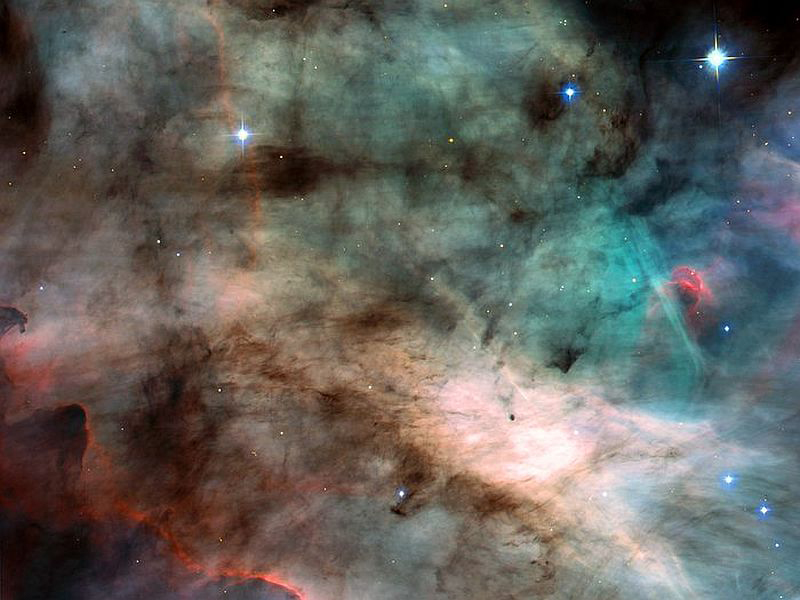Celestial Swan
by Harley White
- Published: Thursday, June 04 2020 20:53

Swans are natural works of art
in form and feature full of grace,
famous for mating from the heart
in lifelong marriage bond embrace.
In legend the swan typifies
serenity, beauty, and peace,
plus purity may symbolize
or true metamorphic release.
A portraiture sensational,
of infant stars in nursery,
for poet inspirational,
has hidden clues precursory
of their growth sidereally
with massive ones making the glow
from cloud heat, materially
streaming off into the tableau.
Thirty-five youthful stars bigger
by twenty to thirty times each
hotter by six than Sun’s vigor
give the brilliant stellar outreach.
It lies within Milky Way’s core
in Archer, Sagittarius,
with hues of aesthetic rapport
and vivid facets various.
Across the canvas of the Swan
or Nebula M seventeen
is limned that lovely paragon
in winsome watercolor scene.
The Omega it’s also named
for a likeness to letter Greek
within the constellation framed
by telescope image technique
where cosmic cloud’s center is shown
amid ferment of newborn stars
in colorful gaseous zone
of stellar cradle reservoirs.
This nebula’s beauteous girth
will finally be undermined,
as radiation from star birth
leaves just a small cluster behind.
The region of the depiction,
five thousand five hundred light-years
afar from the jurisdiction
over our planetary spheres
of Sun the premier provider,
is three thousand five hundred times
than the Solar System wider—
meanwhile we posit paradigms
on the tiny earthly shelter
where nature has let us arise
to our present helter-skelter
assumed command o’er land and skies…
Thus, Swan Nebula will ‘swan song’
sing, as go swan tales old and new,
when death whittles down its lifelong
fling, in an ultimate adieu.
There was an ancient Greek belief
that swans intone a tuneful phrase
in dying moment of their grief
having been silent all their days.
As an aside about this lore,
the familiar swan labeled ‘mute’
has not been known to song outpour
even when death is in pursuit,
albeit the type called ‘whooper’
has been noted when lungs collapse
to issue in dying stupor
a drawn-out string of tones, perhaps
the basis for the ‘swan song’ myth,
plus ‘tundra’ and ‘trumpeter’ breeds
which when wounded utter therewith
some plaintive sounds as life recedes.
Aesop’s fable of ‘Swan and Goose’
says that the stately bird so prized
once caught by mistake was cut loose
when its warble was recognized.
Composed four centuries ago
a madrigal ‘Silver Swan’ states
in lyrical verse apropos,
which yet again the goose berates,
‘The silver Swan had not a Note
while living, but when Death drew nigh,’
to writer’s words rephrase, ‘her throat
unlocked a melodied goodbye.’
‘Farewell,’ said she, ‘all joys, come Death,’
in last lament, ‘come close mine eyes!
More Geese than Swans have life and breath
in age like ours, more Fools than Wise.’
For us this still will resonate
as a fitting allegory
which hints at melancholic fate
owing to human vainglory.
Yet despondency may upend
with the haunting harmonic strains
that to musical heights ascend,
so hope for humanity reigns.
~ Harley White
* * * * * * * *
Inspiration was derived from the following sources, among others…
Image and info ~ Hubble’s newest camera eyes hotbed of star formation…
https://www.spacetelescope.org/images/heic0206d/?fbclid
'The Silver Swan (song) ~ info on Wikipedia…
https://en.wikipedia.org/wiki/The_Silver_Swan_(song)
Orlando Gibbons: The Silver Swan (YouTube) ~ a madrigal by Orlando Gibbons (1583-1625) audio with lyrics, sung by the Tallis Scholars directed by Peter Phillips…
https://www.youtube.com/watch?v=eSAMbicPIgk
Words of madrigal, ‘The Silver Swan’, by Orlando Gibbons:
"The silver Swan, who, living, had no Note,
when Death approached, unlocked her silent throat.
Leaning her breast against the reedy shore,
thus sang her first and last, and sang no more:
“Farewell, all joys! O Death, come close mine eyes!
More Geese than Swans now live, more Fools than Wise.”
Image (among others), info, and video ~ Omega Nebula – Messier 17…
https://www.constellation-guide.com/omega-nebula-messier-17/
Image explanation ~ This image shows the center of the Swan Nebula, or M 17, a hotbed of newly born stars wrapped in colorful blankets of glowing gas and cradled in an enormous cold, dark hydrogen cloud. This stunning picture was taken by the newly installed Advanced Camera for Surveys (ACS) aboard the NASA/ESA Hubble Space Telescope.
Image credit: NASA, Holland Ford (JHU), the ACS Science Team and ESA
Addendum for classical music lovers: Orlando Gibbons (1583-1625) was the leading composer in early 17th century England and a pivotal transitional figure from the end of the Renaissance to the beginning of the Baroque era… Canadian pianist Glenn Gould praised him highly and compared his music, especially for the keyboard, to the likes of Beethoven and Webern. Gibbons paved the way for a future generation of English composers… and was not merely a significant figure in music’s past but a composer who can still speak directly to the present.
Gould plays Gibbons (YouTube)…
https://www.youtube.com/watch?v=WULDLz-WUxM
Note: I was so taken with the madrigal ‘The Silver Swan’, by Orlando Gibbons, first published in 1612, that I listened to it at least once a day while composing the poem. Then I delved deeper into Gibbons and discovered that he was a favorite of Glenn Gould’s, who is a favorite of mine, which led me to keyboard music of Gibbons, indeed quite a discovery for me. At any rate, I strongly recommend listening to the madrigal, since it greatly influenced my poem. ~ HW
Below is the YouTube link to the madrigal again…
https://www.youtube.com/watch?v=eSAMbicPIgk







Comments